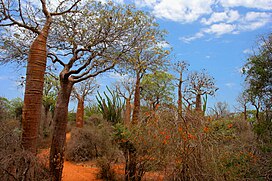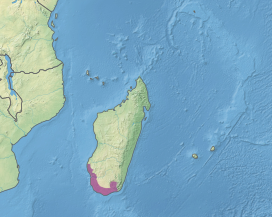|
Madagascar spiny forests
The Madagascar spiny forests (also known as the Madagascar spiny thickets) is an ecoregion in the southwest of Madagascar. The vegetation type is found on poor substrates with low, erratic winter rainfall. The ecoregion contains an outstanding proportion of endemic plant species and is listed as one of the 200 most important ecological regions in the world; one of the Global 200. FloraThis is the area with the highest level of plant endemism in Madagascar, with 48% of the genera and 95% of the species endemic.[2] Many constituent plants show extreme adaptations to drought. Spiny plants of the endemic subfamily Didiereoideae form a conspicuous component, especially towards the east. They are woody but distantly related to the cacti. The remaining component of the forests is dominated by members of the plant families Burseraceae, Euphorbiaceae, Anacardiaceae and Fabaceae, all of which have representatives elsewhere.[3] FaunaNotable inhabitants of the spiny thickets include the spider tortoise (Pyxis arachnoides) and the radiated tortoise (Astrochelys radiata), the gecko Ebenavia maintimainty, several lemurs including Verreaux's sifaka, Grandidier's mongoose, and eight endemic birds.[3] Conservation8.31% of the ecoregion is in protected areas.[1] including Tsimanampetsotsa National Park, Berenty Reserve, Beza Mahafaly Reserve, and Cap Sainte Marie Special Reserve. Andohahela National Park offers limited protection through its 'parcel 3' section. Elsewhere the spiny forest habitat is under pressure from human exploitation. The main impacting activities are burning for conversion to grazing land, harvesting for charcoal and firewood, and logging for construction.[3] The Arboretum d'Antsokay is a botanical garden near Toliara dedicated to preserving the flora of the spiny forest.[4] Extent Ecoregions and forest types in Madagascar [5] As shown on the map on the right, Madagascar can be divided into four climatic ecoregions with four forest types: the moist forest in the East (green), the dry forest in the West (orange), the spiny forest in the South (red), and the mangrove forest on the West coast (blue). Ecoregions were defined following climatic [6] and vegetation criteria.[7] The dark grey areas represent the remaining natural forest cover for the year 2014. Forest types are defined on the basis of their belonging to one of the four ecoregions.[5] See alsoReferences
External links and bibliographyWikimedia Commons has media related to Madagascar spiny forests.
|
||||||||||||||||||||||||||||||||||||||
Portal di Ensiklopedia Dunia

